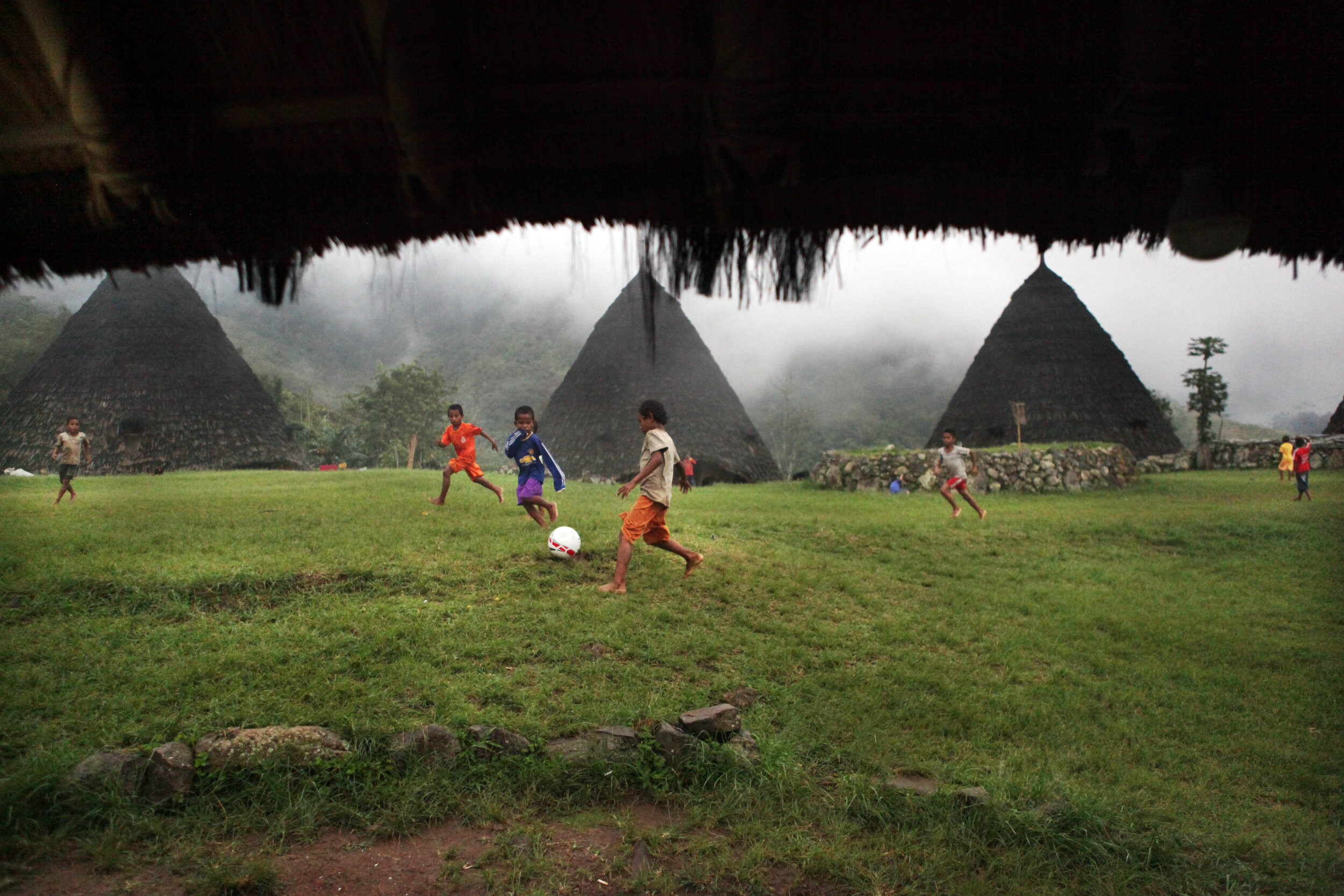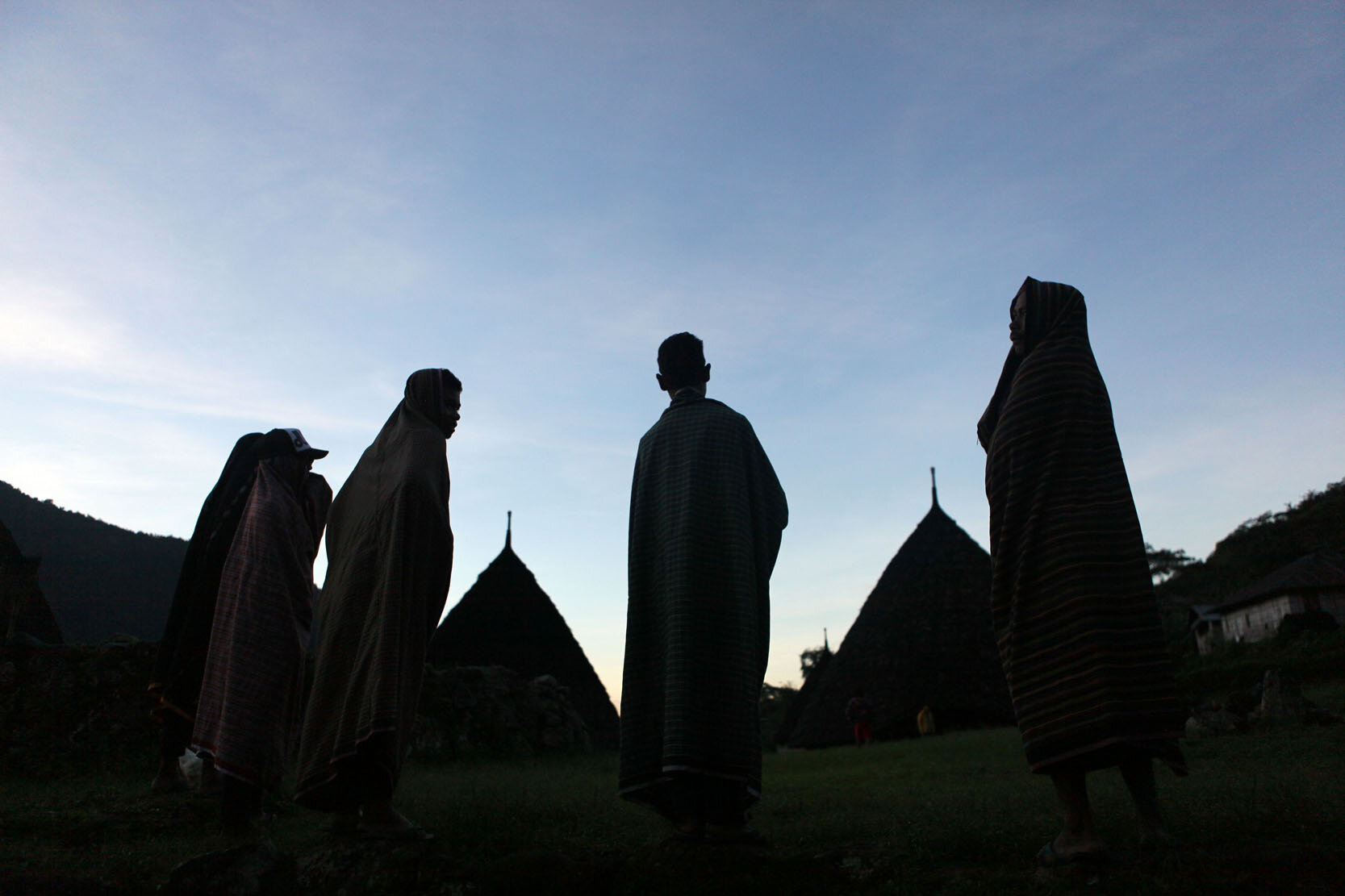
Mohe Waerebo
East Nusa Tenggara, Indonesia, July 2016
© Roni Bintang
Almost 20 years since the first foreign visitor to Wae Rebo looked through the forest and saw the ancient conical houses below, the way of life there is slowly changing. The isolated village in the Manggarai district of West Flores, Indonesia, is the last to maintain its traditional houses, and where the culture is still practiced, from agriculture to ceremonies.
When Japanese photographer Matsuda Shuikhi made the first recorded visit in 1997, the hike was about 20km, starting at Dintor village, on the coast. Today, it is still a difficult four-hour walk uphill, but begins on an asphalt road 9km from the village, which sits 1100m above sea level.
Since the world found out about Wae Rebo, tourism has escalated, from 425 people in 2011, to 3741 in 2015, not counting Indonesian visitors. They pass dense forest and cross cold rivers until they reach the bamboo bridge that signals Wae Rebo is near. They arrive through a small house where they see the village below for the first time, and shake a bamboo instrument to announce they have arrived.
A village leader, Alexander Ngadus, 69, greets guests with a ceremony inside the Niang Gendang, one of the seven houses, which are known as Mbaru Niang houses. Mbaru means house, and niang means tall and round. The building houses eight families, while the others each house six families.






Inside it is dark, and guests sit on woven mats in a circle, which symbolizes the unity of the Wae Rebo people. Guests pay IDR 20,000 (USD 1.50) at this ceremony, and can pay another IDR 325,000 (USD 25.00) each to stay the night in a specially built Mbaru Niang house.
The Wae Rebo people continue their normal life and tourists are welcome to visit the houses. Some guests bring sweets or books for the children, while one woman gives out cash notes to the children, causing one child who missed out to cry. Alex says he believes Wae Rebo’s culture will stay strong, as long as the children remain interested in their special traditions.
“There is no special school to learn our culture,” he says. “I’m not worried about this generation as long as they come to see the Penti ritual every year."
The Penti ritual is an annual thanksgiving, to bless the harvest and the journey of life in the coming year. The gathering every November includes the Sanda song and Caci dance, which are only performed then. Alex also believes the character of Wae Rebo people will remain the same as long as they continue their agricultural practices. Organic coffee is grown on the hillsides around the village. Traditionally it was exchanged with outside villages for rice, which Wae Rebo people do not grow.
Today, the coffee is also sold to outside markets through a trader in West Java. Coffee is valuable to the community and takes a lot of its time.
Beans are picked, peeled and dried using only traditional methods. Besides coffee, the Wae Rebo diet consists of chicken, as well as sweet potato, corn and other vegetables. To buy rice or other foods, villagers walk the 9km path down the mountain, as they always have.
Children must also leave the village for school. In the 1920s, a village called Kombo was created 11km away as a second community for families whose children were attending school.




Until recently, the walk there was difficult and kids would board with other families during the school year, perhaps only returning to Wae Rebo a few times. Now the path is better and they can return on most weekends to participate in traditional life. In total, 118 families - around 600 people - live between Kombo and the six Wae Rebo houses.
Martinus Anggo, 47, left Wae Rebo as a child for school, went to seminary school in the Philippines, and remained outside the village. He runs a guesthouse at Dintor, the town on the coast below Wae Rebo, and can see the positive and negative changes that the tourism has brought. For one thing, the income has given people access to better nutrition. In Indonesia, rice is considered an important staple of the diet. In Wae Rebo, people were eating rice only three to four times a month and it was considered one of the poorest villages in Flores on that indicator. But Martin says life was simpler when villagers had only farming to be concerned with.
“The negative change has been the mindset of people becoming materialistic, they are always thinking of money now,” he says. Martin recalls that in this father’s era, they played the Mbata drum for enjoyment. Now, people consider playing the music for profit. “Even culture can be used to make money,” he says. If you visit Wae Rebo, you will notice that work keeps people very busy.




Solar generators bring electricity to the village for only a few hours every night, and most tasks are done the old way. Women cook on a fire at the centre of the homes, which have only a little light during the day from the small windows. Around the outside of the circular floor of the houses are the small bedrooms, each big enough for a small mattress only.
Most people wear modern clothes and some even have mobile phones, but they must walk a long way to get a signal. In 2007, the community reached a turning point. Only three of the seven houses remained standing, and the people of Wae Rebo had to choose whether to build modern homes, or gather support to save the Mbaru Niang houses. Not-for-profit groups raised the funds for construction, which was done by the local community.
In the process, they realized the potential for eco-tourism and got support to build the visitor home and accommodate guests. Cooking and serving the visitors is shared among the families who wish to participate. The people of Wae Rebo are busy, but welcoming to guests. They are Catholic, but maintain animist beliefs particular to the village, creating unique rituals and traditions. For instance, the Compang, the stone altar at the centre of the village, is a sacred place to worship both God and the ancestors.
Two Swiss tourists at Martin’s guesthouse return from visiting Wae Rebo and say they were confused by the experience. People were doing ordinary work and there was no performance or display, they say. But at Wae Rebo, the culture is not for show as it is in some other tourist destinations. It is a living, everyday thing. Kasius, 24, left Wae Rebo to attend university in Sulawesi but returned to Flores after one year.
He worked on ships and in restaurants in the port town of Labuan Bajo, which is popular with European divers. But last year, he decided to leave that and return to Wae Rebo. He has married and will remain in the village to coordinate the guesthouse. Kasi remembers his sadness leaving Wae Rebo the first time, when he was six years old.
At that time, parents had to encourage kids to become more independent before sending them to Kombo for school. Kasi says access to education is a major change that can only bring benefits to his community. He hopes an elementary school will one day be built closer to the village, so children can remain there and be active both in learning and family life. Kasi is positive about the future of Wae Rebo.
“I hope that Wae Rebo people can keep our culture alive so this village will exist in the future.”
Mohe Waerebo (Long live Wae Rebo)


